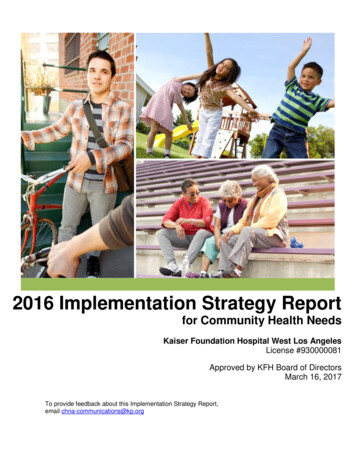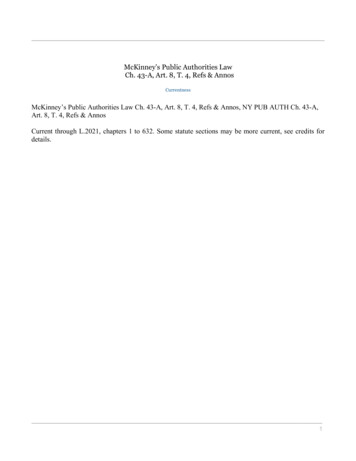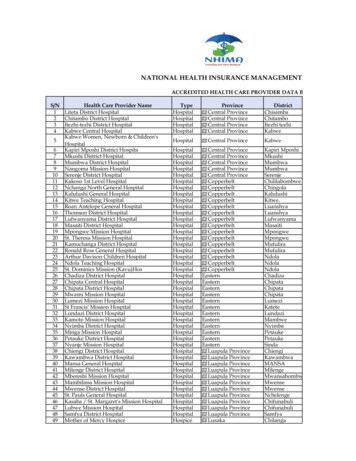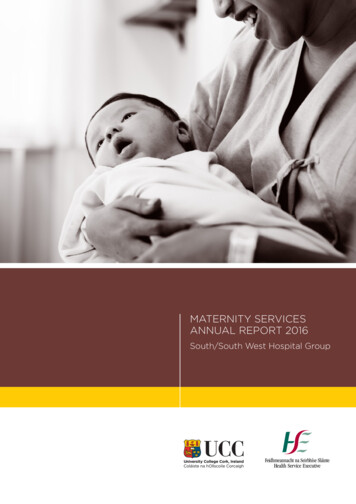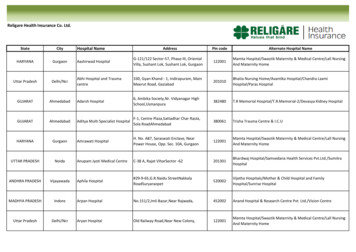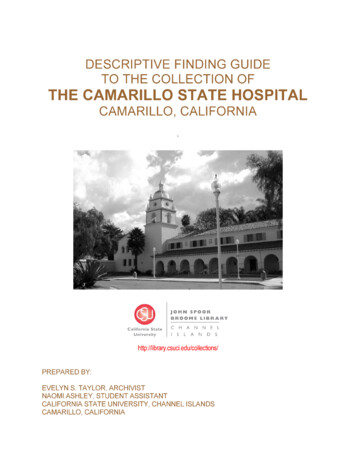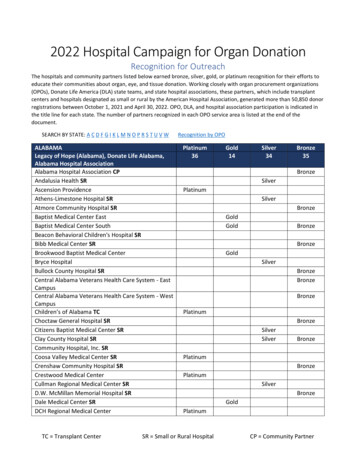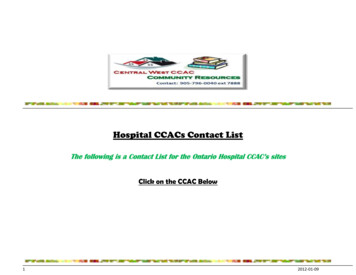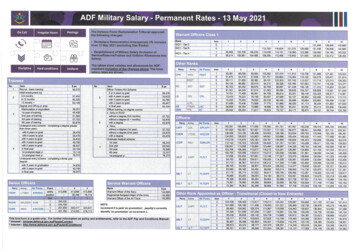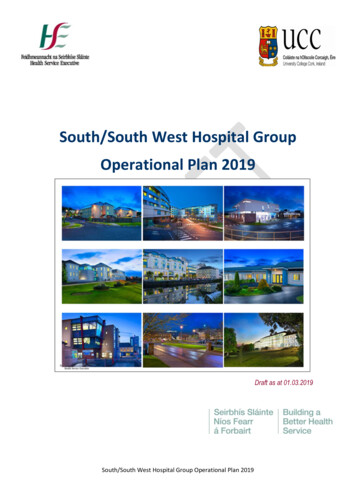
Transcription
South/South West Hospital GroupOperational Plan 2019Draft as at 01.03.2019South/South West Hospital Group Operational Plan 2019
To be included on inside coverSouth/South West Hospital Group Operational Plan 2019Date of publication of Delivery Plan to be included on inside cover
ContentsForeword from the Chief Executive Officer . 21.Introduction. 42.Our Population . 73.Reform and Transformation . 114.Clinical, Quality and Patient Safety . 135.Population Health and Wellbeing . 166.Health and Social Care Delivery . 216.1 Unscheduled Care - Unplanned/Emergency Care . 246.2 Scheduled Care . 266.3 Specialist Services . 286.4 Women and Children’s Services . 306.5 Cancer Services . 327.Finance . 348.Workforce . 39Appendices. 44Appendix 1: Financial Tables . 45Appendix 2: HR Information . 46Appendix 3: National Scorecard and Performance Indicator Suite . 47Appendix 4: Capital Infrastructure. 55South/South West Hospital Group Operational Plan 2019
Foreword from the Chief Executive OfficerAs CEO of the South/South West Hospital Group (S/SWHG) I am pleased to presentthe 2019 South/South West Hospital Group Operational plan.While 2018 was a challenging year progress has been made in a number of keyareas, which has achieved real benefit to patients and service users.Significant progress was made in 2018 in respect of the clinical leadership of healthservices within the S/SWHG through; The implementation of the Clinical Directorate for Maternity Services;The new model of Executive Clinical Leadership established commencing with the role of theExecutive Medical Clinical Lead for S/SWHGThe implementation of Clinical Leads roles in the areas of Endoscopy, Paediatric Services andCancer Services.Arising from the National Clinical Programmes and new Models of Care, service re-design workcommenced in 2018 in a number of specialties in the S/SWHG including; Maternity, Paediatrics,Trauma and Rehabilitation, ICU, Radiology, Cardiology, Vascular Surgery and Cancer. Furtherorganisational redesign of clinical services in accordance with the National Clinical Programmes willcontinue and is a key priority for the Group in 2019.The appointment of the Board of Directors to the S/SWHG on an administrative basis, in November2017, marked a significant and welcome development in Group governance pending the necessarylegislation which would establish the Group as an independent legal entity. In 2018, the Groupcontinued to develop in preparation for transition to an independent body.In relation to integrated care, there was continued focus on integration of services including theidentification of targeted prevention programmes towards improving Population Health and ChronicDisease Prevention Programmes in the areas of Ambulatory Care, COPD, Cardiovascular and Stroke.Sláintecare ReportThe S/SWHG welcomes the significant level of change which is planned for health services in Ireland.In particular, the Sláintecare Report provides an opportunity to prepare our acute services to meet theneeds of future generations.One highly significant recommendation arising from Sláintecare is the commitment to build a newelective hospital and diagnostic centre in Cork for the Group which will greatly facilitate service redesign and enhance access to services throughout the Group.Demographics:The S/SWHG has responsibility for the provision of acute hospital care for a population of 900,000people across the counties Cork, Kerry, Waterford and South Tipperary and a supra-regional catchmentof 1.2 million. Employing 11.8 thousand people (10.3 thousand WTEs) highly skilled and caring staff,2South/South West Hospital Group Operational Plan 2019
the Group aims to deliver excellent clinical outcomes and a great experience for all our patients andtheir families.As a cohesive Hospital Group, the S/SWHG aims to make choices to drive quality, access to care,integration of services and organisational excellence that best meet the needs of its population, whilealso promoting the Group as an employer of choice for highly skilled professionals into the future.This year will present a significant challenge to meet the demands on our services which continue torise as well as the challenge of meeting the needs of an older population.Over the next 15 years, the population of the S/SWHG is set to increase by 9.6% to 1 million. Inparticular, the population aged over 65 who are the main consumers of healthcare is set to increase by54% in that time, with an 81% increase among those aged 75 and over. Unsurprisingly, a larger olderpopulation creates increased demand on the health service, specifically in relation to the health andsocial care needs of the frail elderly and also managing chronic illnesses.Financial Challenge:As set out in the introduction and finance sections of this plan there are a number of overarching risksto the delivery of the Operational plan in 2019.The preparation of a plan that is financially balanced and at the same time seeks to respond to themost pressing service quality and safety issues in 2019 has presented a significant challenge.It has been necessary to consider carefully how the entirety of funding made available to the Group isbeing used and whether there is scope to reshape or reprioritise activities where this can deliver betteroutcomes.Within this plan the Group have sought to respond to the most pressing patient and service user needswhile also prioritising some small investments in critical transformation and reform programmes of work.Capital:Discussions with Estates are on-going in relation to Capital projects for 2019, however, it is recognisedthat this may be a challenging year for capital including minor capital and urgent repair works requiredin all hospitals within the Group. We will work closely with Estates and our Hospitals in relation to theseissues.In developing this Operational plan for our Group, we are conscious of the vital role that our hospitalsfulfil in the delivery of health services to patients, services users and their families and I would like totake this opportunity to acknowledge the contribution of staff within the S/SWHG over the past year.Mr Gerry O’Dwyer,Group CEO,South/South West Hospital Group3South/South West Hospital Group Operational Plan 2019
1. IntroductionIn line with the National Service Plan 2019 (NSP2019), the South/South West Hospital Group(S/SWHG) Operational Plan 2019 has been prepared in response to the funding allocation andassociated requirements. This Plan sets out the type and volume of acute hospital services to beprovided by the S/SWHG in 2019 having regard to the funding and level of staff made available.The overall NET allocation to the S/SWHG for 2019 is 866.901(m). This represents a maximumamount of expenditure that may be incurred by the Hospital Group during the forthcoming financialyear.For 2019, a key priority for the S/SWHG is to ensure that the resources which have been madeavailable to hospitals are targeted towards providing care and support for those patients most in need,and ensuring that these services are delivered efficiently and effectively, consistent with best availableevidence.This Plan provides a view of our population and healthcare need in addition to our reform andtransformation priorities. The Plan sets out our overarching priorities and specific actions to beprogressed by the S/SWHG during 2019 to deliver improved population health, and acute hospitalservices within a defined financial framework. New services are in line with government policy, includingservices which will be delivered as part of the termination of pregnancy.Service Quality and ImprovementThe S/SWHG together with the HSE has committed itself to continuous learning and as such, werecognise that there are significant opportunities for improvement in some of our services and we arestriving to secure these. We know from surveys of patient experience that, while many people arehappy with the service they receive, others unfortunately have difficulties in accessing services, or havea poor experience when they do. A priority in 2019 is to continue to build capacity within each of ourhospitals, to anticipate and respond to risks and challenges effectively and to strive for a culture thatgenuinely focuses on continuously improving quality of service for patients, and values innovation.Findings from the Scoping Inquiry into the CervicalCheck Screening Programme, 2018 (Scally Report)and other HSE reports have highlighted areas which need immediate attention. Ensuring real andmeaningful involvement and engagement between patients, service users, families, healthprofessionals and organisations across our services will receive a renewed focus in 2019.Service RedesignThe S/SWHG have been very focused on re-designing services to ensure that the most appropriatecare is delivered in the most appropriate setting across our Hospital Group. This includes the recentdevelopment of the Maternity Directorate across our four Maternity sites, development of a VascularReport across the Group, and the need for an Elective Hospital.In addition, the S/SWHG has worked very closely with our community colleagues and have developedmany integrated services that have greatly benefitted patients. We will continue to further develop andenhance these services during 2019. Some of these initiatives have been the development of4South/South West Hospital Group Operational Plan 2019
Community Intervention Teams, Local Governance Groups for Unscheduled Care, the roll out of theFive Fundamentals, as well as the enhanced roll out of outreach maternity services.Our principal challenge is to transform the way we deliver services, while in parallel continuing to meetthe current needs of patients under the existing system. Dealing with and responding to increaseddemand across a whole range of acute hospital services and delivering programmes of work to improveservice efficiency and meet the goals and objectives of key government strategies, is an on-goingfeature of health service management and delivery.Service ChallengesThe funding of 866.901(m) made available to the S/SWHG in 2019 represents an increase of 23.362m (2.77%) over the final budget for 2018. This funding is required to meet the costs of newservice developments set out by the DoH, the higher costs in 2019 of delivering 2018 levels of serviceactivity as a result of centrally agreed pay rate and pension changes as well as other price increases,and the costs in 2019 of additional service activity to meet demographic changes and other servicepressures.In this context, endeavouring to prepare a plan that is financially balanced and, at the same time, seeksto respond to the most pressing service quality and safety issues in 2019 has presented a verysignificant challenge. It has been necessary for us to consider carefully how the entirety of fundingmade available to the S/SWHG is being used and whether there is scope to reshape or reprioritiseactivities where this can deliver better outcomes.The S/SWHG Operational plan 2019 has been prepared on the basis of a range of assumptions andwith careful consideration of risks to delivery. These are outlined below. Further details are provided inthe subsequent sections of the Plan. Delivering a volume of activity in 2019, consistent with available funding and reflecting improvedefficiency.Delivering a volume of activity in 2019 in demand-led service areas (e.g. emergency hospitalservices) – which are not usually amenable to normal budgetary control measures – which exceedsbudgeted levels of activity and available funding.Ensuring an adequate response to the additional service pressures which will arise during thewinter period in relation to hospital services. In preparing for winter, we have prioritised funding toanticipate and manage critical demand pressures, within the funding envelope available.Ensuring that the S/SWHG service delivery operates within notified financial and staffing budgetlevels for 2019, and also ensure appropriate balancing of quality and risk issues at local levelduring a period of potential structural change, with escalation nationally as appropriate.Effectively managing our workforce, including recruitment and retention of a highly skilled andqualified workforce, delivering a reduction in overtime and the use of agency personnel and stayingwithin our pay budget.Working within the constraints posed by limitations to clinical, business, financial and HRinformation systems.5South/South West Hospital Group Operational Plan 2019
Responding adequately to urgent safety concerns and emergencies such as CarbapenemaseProducing Enterobacteriaceae (CPE), in the context of the resources available.Responding adequately to the impact of the Brexit process, in the context of the resourcesavailable.Responding adequately to unplanned and unforeseen events (e.g. further storms), in the absenceof a contingency fund in 2019.Meeting public expectations in terms of access to services, new therapies, drugs and interventions,in the context of the resources available.Ensuring that levels of activity and costs in screening services, as a result of laboratory demandsand requirements, remain within budgeted levels.Responding adequately to recommendations in new and existing reviews and reports, in thecontext of the resources available.Meeting the regulatory requirements in hospital services, within the limits of funding availablewithout impacting on service levels.Complying with the General Data Protection Regulation (GDPR) requirements.We will keep these and other risks under on-going review to ensure that they are mitigated as far aspossible.Performance and AccountabilityA key principle of Sláintecare and enhanced operational management and oversight is the need forstrengthened governance and accountability, at all levels.During 2019, we will work with our S/SWHG Board, the new HSE Board, the DoH and relevantstakeholders to progress the development of new health service structures in line with Sláintecare.StructureThe remainder of this document is structured as follows: Section 2: Our Population Section 3: Reform and Transformation Section 4: Clinical, Quality and Patient Safety Section 5: Population Health and Wellbeing Section 6: Health and Social Care Delivery Section Section 7: Finance Section 8: Workforce6South/South West Hospital Group Operational Plan 2019
2. Our PopulationOver 4.8m people live in Ireland (Central Statistics Office (CSO), 2018). An overall increase in thepopulation of 64,500 was experienced from April 2017 to April 2018, the largest annual increase since2008 (Population and Migration Estimates April 2018).The greatest change in population structure over the last ten years is the growth in both the proportionand the number of people aged 65 years and over, increasing in the intercensal period from 11.6% in2011 to 13.3% in 2016. It is projected that people aged 65 years and over will increase by 22,935(3.5%) in 2018 and 21,969 (3.3%) in 2019 (Population and Labour Force Projections 2017-2051).Similarly, adults aged 85 years and over will increase by 2,505 (3.6%) in 2018 and by 3,116 (4.3%) in2019. Notwithstanding this growth in the older population, in 2016 a quarter of our population werechildren aged 0-17 years.The S/SWHG provides acute hospital services to approximately 900,000 (19% of the population of theState), and a wider catchment of 1.2m which includes Carlow, Kilkenny and Wexford. Analysis of thearea of residence of patients who admitted to S/SWHG in 2017 shows that the majority of patients arefrom the counties of Cork, Kerry, Waterford and South Tipperary. Patients from neighbouring regionssuch as the Mid-West are also admitted to S/SWHG. Patients from the wider South East counties,Carlow, Kilkenny and Wexford, are routinely admitted and also albeit to a lesser extent from the MidWest, for specialty areas such as plastic surgery.According to 2016 census data, the age profile of the population served by the S/SWHG is older thanthe national average, despite serving two large cities Cork and Waterford. 21.9% of the catchmentpopulation are categorised as deprived based on current deprivation indicators. 15.4% of the region’sworkers are semi/un-skilled in comparison to the national figure of 14.1%. (Health Atlas CSO Census2016). Over the next 15 years, the population of the S/SWHG is set to increase by 9.6% to 1 million. Inparticular, the population aged over 65 who are the main consumers of healthcare is set to increase by54% in that time, with an 81% increase among those aged 75 and over. (Health Atlas CSO Census2016) Furthermore, the ESRI predicts that population growth will centre in urban areas, particularly theCork city area, and it is thought that there will be an additional 115,000 people living in Cork city aloneby 2040. This trend is evident in the distribution of population growth between 2011 and 2016.These statistics provide a brief profile of the size, growth and distribution of our population – thedemographic changes which have implications for future planning and health service delivery. (Figure1).7South/South West Hospital Group Operational Plan 2019
Figure 1: S/SWHG Population Profile.8South/South West Hospital Group Operational Plan 2019
Life Expectancy and Health StatusLife expectancy in Ireland has increased by almost two and a half years since 2005 and is now abovethe EU average with women living to, on average, 83.4 years and men 79.6 years. The greatest gainsin life expectancy have been achieved in the older age groups reflecting decreasing mortality rates frommajor diseases (Health in Ireland – Key Trends 2017, DoH). People living longer demonstrates that weare managing to prevent and treat diseases more effectively. Mortality rates from circulatory systemdiseases decreased by 31.5% between 2007 and 2017, and cancer death rates decreased by 11.3%over the same period. Transport accident mortality rates have fallen by 44.5% in the past decade, andsuicide rates by 26% in the same period (provisional figures provided by the DoH for Health in Ireland –Key Trends 2018).Chronic DiseaseThe demand for acute hospital services continues to increase in line with a growing and ageingpopulation. Unsurprisingly, a larger older population creates increased demand on the health service,specifically in relation to the health and social care needs of the frail elderly and also managing chronicillnesses. As people age, chronic illnesses become more prevalent and it is estimated that itsprevalence will grow by 29% by 2020. Acute services continue to optimise the management of chronicdiseases and older persons’ care in conjunction with primary and older persons’ services to helppatients avoid hospital, wherever possible, and receive quality care at home. An integrated populationneeds assessment, and specifically disease/care group population needs assessments, are currentlybeing conducted by the S/SWHG in conjunction with Cork Kerry Community Healthcare Organisation(CKCHO) and Public Health HSE South. On completion of a gap analysis, areas of unmet need andmaximum population impact will be prioritised and identified in need of urgent action and furtherinvestigation.The S/SWHG is committed to ensuring that all hospitals, irrespective of size, work together in anintegrated way to meet the increased demand of a larger older population it serves, with an increasedfocus on smaller hospitals managing routine or planned care locally and more complex care managedin the larger hospitals. Furthermore, a close partnership with community healthcare organisations willensure the achievement of better outcomes and better care for those living with chronic illness.Healthy Ireland, our national policy, promotes a reduction in health inequalities through improvedlifestyle and health behaviours. This is an inter-sectoral whole of government approach to ensuring animprovement of the wider determinants of health. The Healthy Ireland / HSE policy priority programmesfocus particularly on population health issues such as overweight and obesity, child health, mentalhealth, smoking, alcohol and drugs, and positive ageing. Healthy Ireland provides people andcommunities with accurate information on how to improve their health and wellbeing and seeks toempower and motivate them by making the healthy choice the easier choice.9South/South West Hospital Group Operational Plan 2019
Implementing Priorities in 2019PriorityPriority ActionTimelineLeadImprove staff health andwell beingSupport staff health and well-being initiativesQ1- Q4HRSupport theimplementation ofcomprehensive HealthyIreland Implementationplan for S/SWHGCommence the implementation of Healthy IrelandFramework using a multi-disciplinary teamapproachQ1-Q4HRIncrease the uptake of FluVaccineContinue the roll out of education sessions andinitiatives together with our community colleaguesto improve the update of the Flu vaccine amongststaff across the S/SWHG and CHO’sQ1-Q4Group NurseLead10South/South West Hospital Group Operational Plan 2019
3. Reform and TransformationOver the last five years, the HSE has had programmes of work focusing on four pillars of healthcarereform. Significant work has been delivered under the health and wellbeing pillar, the financial reformpillar, the service reforms pillar and Hospital Groups and CHOs were established under the ‘structuralreform’ pillar. During this time, the HSE advocated the need for a whole of government, cross-partyvision for health and this was made possible by Government and delivered with the publication of theSláintecare Report in May 2017.Figure 3: Principles set out in the Sláintecare ReportImplementation of SláintecareThe Sláintecare Report (2017) and SláintecareImplementation Strategy (2018) signal a new directionfor the delivery of health and social care services inIreland. The S/SWHG will work closely with theSláintecare Programme Office and relevantstakeholders such as the Strategic TransformationOffice to progress the design and development of newRegional Integrated Care Organisations (RICOs) in linewith Sláintecare.To support the implementation of Sláintecare, theS/SWHG will continue its comprehensive changeprogramme with the continued roll out of the MaternityServices Directorate. Work will continue on thedevelopment of the New Elective Hospital which willrequire a detailed review of all services across the S/SWHG. This will inform the necessary serviceredesign programme that to ensure the appropriate services operate from this new hospital.The Sláintecare Implementation Strategy sets out four over-arching goals, ten high-level strategicactions and eight principles (see Fig 3.). These underpin the first three years of the reform programme,and represent a mix of legislative, policy and service-level actions.S/SWHG is committed to working with the Sláintecare Programme Office and all stakeholders to playour part in successfully bridging the gap between the vision for health service transformation in Irelandand delivery of that change at the frontline. Changes will result in more positive experiences and betteroutcomes for patients, service users and their families.Given the need to ensure Sláintecare becomes fully embedded in everything we do, in addition tosimultaneously being mindful of real service challenges and further structural reconfiguration, five highlevel reform and transformation priorities have been identified by the HSE for 2019. These include: Governance, leadership and corporate strategy. Transitional funding to shift the balance of care. Managing demand and continuing productivity improvement.11South/South West Hospital Group Operational Plan 2019
Delivering programmes of work aligned to the National Sláintecare Office Action Plan. Transformation support and enablement.S/SWHG Priorities for 2019 include: Develop the group-wide quality & patient safety management system to provide assurances thatsafe, effective and person centered care is delivered across the S/SWHG in compliance with thenational standards for Safer Better Healthcare.Establish integrated Corporate and Clinical governance structures, processes and outcomesmeasurement in order to assure compliance with national policy, standards and best practice. Thereview of existing approved models of care to ensure services within the SSHWG are provided on agroup wide basis through the further development of group wide clinical directorates.Finalise and implement the S/SHWG Strategic Plan (2019 – 2024).Work closely with Cork / Kerry Community Healthcare and South East Community Healthcare toimplement Sláintecare programme, to expand current integration of care across acute and primarycare areas to develop new and further optimise community delivered models of care.Develop the eHealth capacity across the S/SWHG to support the delivery of services across theS/SWHG.Continue to develop the PMO capacity within the S/SWHG to support and drive the change andreform agenda across the group.S/SWHG will work with the CHO’s to develop a population needs assessment that will supportregional service planning.S/SWHG will continue to strengthen all programmes to work on delivering on the Healthy IrelandFramework across the S/SWHG.12South/South West Hospital Group Operational Plan 2019
4. Clinical, Quality and Patient SafetyIntroductionThe S/SWHG will continue to work to support the delivery of sustainable high-quality, effective,accessible and safe health and social care services to meet the needs of our population. In line with theNational Service Plan 2019 progress actions will be in line with the three priority areas of the HSE: Strengthening clinical leadership in the development of healthcare strategy and in the planning andmanagement of our services at a time of critical service transformation signalled by the SláintecareReport.Improving patient and service user engagement to ensure that the priorities of patients and serviceusers inform service planning which is designed around their needs, enhancing patient safety andimproving overall patient experience.Advancing a culture of patient safety, continuous quality improvement and learning.Strengthening Clinical LeadershipIn line with HIQA Standards, HIQA Investigation reports, the National Womens & Infants HealthcareProgramme (NWIHP) and the S/SWHG Risk Review Report, a Group Clinical Director for MaternityServices was appointed in February 2017. The maternity services directorate has been established anddeveloped, utilising a programmatic approach supported by the programme management office of theS/SWHG. Since establishment of the Directorate, processes are being standardised across the fourmaternity units. A steering group is overseeing the work of the Directorate in its design of the futuremodel of service delivery and governance across the four maternity units. It is envisaged that theproject will reach a critical point in 2019 when the governance and associated budget for the fourmaternity units transfers to the Group Clinical Director.Arising from meetings with Clinical Directors across our hospitals, the Group intends to enhance therole of on-site clinical directors and appoint clinical leads for selected specialities. Engagementsessions with staff and in particular current Clinical Directors and Clinical Leads emphasised the needfor site based operational clinical governance reinforced by cross-site strategic clinical leadership. Sitebased Clinical Directors would report to the local Hospital Manger with a dotted line reportingrelationship to the Executive Medical Director (EMD) at Group level. The EMD would also chair a forumof all CDs and Clinical Leads on a quarterly basis. Such a structure would provide strategic direction,operational efficiency, shared thinking and learning from meaningful clinical networks managed acrossdisciplines in the Group. Clinical leads will be a
South/South West Hospital Group Operational Plan 2019 1. Introduction In line with the National Service Plan 2019 (NSP2019), the South/South West Hospital Group (S/SWHG) Operational Plan 2019 has been prepared in response to the funding allocation and associated requirements.
